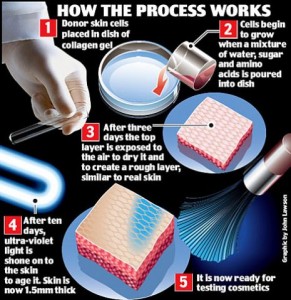There are two main types of animal testing alternatives: in vitro and in silico.
——————————————————————
In vitro involves the use of cell cultures.
 EpiDerm™ and EpiSkin™ can be replacements for animal-based skin corrosion studies. They are made up of human-derived skin cells, cultured to form a multi-layered model of human skin.
EpiDerm™ and EpiSkin™ can be replacements for animal-based skin corrosion studies. They are made up of human-derived skin cells, cultured to form a multi-layered model of human skin.
- Corrositex™ is another method for assessing skin corrosion. A protein membrane is used instead of skin, and it can measure whether the testing chemical can penetrate the skin barrier and the rate at which it penetrates.
 Phototoxicity is caused by being exposed to a chemical then subsequently bring exposed to ultraviolet radiation. Phototoxicity results in skin inflammation.
Phototoxicity is caused by being exposed to a chemical then subsequently bring exposed to ultraviolet radiation. Phototoxicity results in skin inflammation.
- 3T3 Neutral Red Uptake Phototoxicity Test tests for phototoxicity in a chemical by exposing cells to a test chemical from the 3T3 cell line. 3T3 cells are derived from mouse embryonic fibroblast cells to form a culture. Phototoxicity can be measured by the cell culture’s ability to recover after being exposed to the chemical in the presence versus absence of light.
- A skin patch test using human volunteers can be a replacement for skin irritation studies in animals. Only non-corrosive and non-irritation chemicals can be used in a human skin patch test.
- Micro-dosing involves giving human volunteers a very low dose of a given drug to observe the effects at a cellular level. There is virtually no risk to the drug recipient. Animal testing is reduced because drugs that are ineffective on humans are eliminated before any animal testing with larger doses begins.
- An in vitro Pyrogen Test can use blood donated by healthy human volunteers to observe the reaction between white blood cells (in the immune system) and the test drug.
In silico alternatives involve simulation of chemical, molecular, and cellular interactions with the use of computer models.
Research is currently being done to integrate in vitro and in silico testing methods. The goal is to further improve our ability to understand the potential toxic effects of new chemicals and ultimately reduce the reliance on live animal testing.
